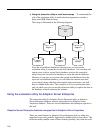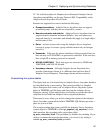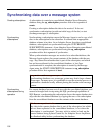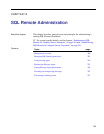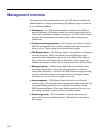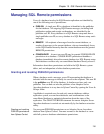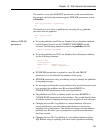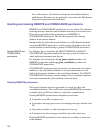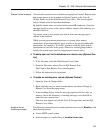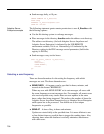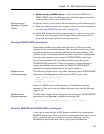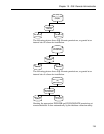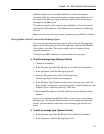
loss of information. You should not change the consolidated database
publisher user ID unless you are prepared to close down the SQL Remote
setup and resynchronize all remote users.
Granting and revoking REMOTE and CONSOLIDATE permissions
REMOTE and CONSOLIDATE permissions are very similar. Each database
receiving messages from the current database must have an associated user
ID on the current database that is granted one of REMOTE or
CONSOLIDATE permissions. This user ID represents the receiving
database in the current database.
Databases directly below the current database on a SQL Remote hierarchy
are granted REMOTE permissions, and the at most one database above the
current database in the hierarchy is granted CONSOLIDATE permissions.
Setting REMOTE and
CONSOLIDATE
permissions
For Adaptive Server Anywhere, the GRANT REMOTE and GRANT
CONSOLIDATE statements identify the message system and address to
which replication messages must be sent.
For Adaptive Server Enterprise, the sp_grant_remote procedure sets
REMOTE permissions, and the sp_grant_consolidate procedure sets
CONSOLIDATE permissions.
CONSOLIDATE permissions must be granted even from read-only remote
databases to the consolidated database, as receipt confirmations are sent
back from the remote databases to the consolidated database. The GRANT
CONSOLIDATE statement at remote Adaptive Server Anywhere databases
is executed automatically by the database extraction utility.
Granting REMOTE permissions
Each remote database must be represented by a single user ID in the
consolidated database. This user ID must be granted REMOTE permissions
to identify their user ID and address as a subscriber to publications.
Granting REMOTE permissions accomplishes several tasks:
♦ It identifies a user ID as a remote user.
♦ It specifies a message type to use for exchanging messages with this user
ID.
♦ It provides an address to where messages are to be sent.
♦ It indicates how often messages should be sent to the remote user.
Granting REMOTE permissions is also referred to as adding a remote user
to the database.
204



